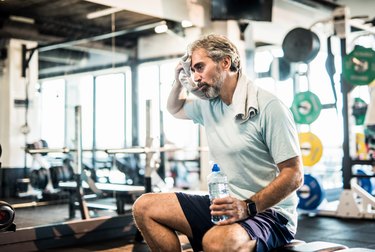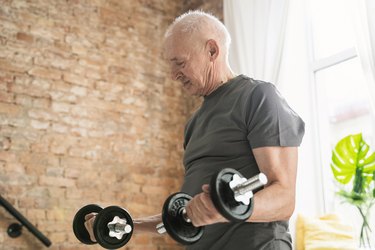
Fatigue is more than just yawning through an afternoon meeting — it can have a huge affect on your lifestyle, including your motivation to workout. And after age 50, it may become more prevalent.
In fact, a third of people over 51 experience fatigue, per a classic October 2011 study in the Journal of the American Geriatrics Society. The numbers are even more staggering if you're living with a chronic disease. Forty to 74 percent of older adults living with a chronic disease experience some level of fatigue, per a June 2018 study in Health Psychology.
Video of the Day
Video of the Day
That said, staying active is an important part of your overall health, especially as you grow older. One of the most important reasons to exercise when you're over 50 is to maintain a healthy weight, which can in turn lower your blood pressure and reduce your risk of heart disease, arthritis and diabetes, per Johns Hopkins Medicine.
Here's what experts say about why you may feel too tired to work out if you're over 50 — and what to do about it.
What Causes Fatigue Over 50?
Fatigue is common in older adults and can be a normal part of aging. The feeling of weariness and lack of energy known as fatigue may be a regular response to physical activity, boredom or lack of sleep, but it can also signal bigger problems.
According to the National Institute on Aging, fatigue can be caused by:
- Medical problems and treatments
- Treatments, like chemotherapy and radiation
- Recovering from major surgery
- Infections
- Chronic diseases like diabetes, heart disease, kidney disease, liver disease, thyroid disease and chronic obstructive pulmonary disease
- Untreated pain and diseases like fibromyalgia
- Anemia
- Sleep apnea and other sleep disorders
- Recent stroke
- Parkinson's disease
- Certain medications like antidepressants, antihistamines and medicines for nausea and pain
- Emotional exhaustion
- Anxiety
- Depression
- Grief from loss of loved ones
- Stress from financial or personal problems
- Feeling that you no longer have control over your life
- Lifestyle habits
- Staying up too late
- Having too much caffeine
- Drinking too much alcohol
- Getting too little or too much exercise. While regular exercise can help to increase your energy levels, doing too much or not getting enough rest in between workouts can cause stress and fatigue.
Older adults are also particularly prone to altered sleep patterns that may lead to exhaustion during the day.
"They tend to have lighter sleep and wake up throughout the night more often, which can cause daytime fatigue and low energy levels," says Raj Dasgupta, MD, a board-certified pulmonary, critical care and sleep medicine physician. "Also, sleep conditions, such as sleep apnea and insomnia, are more common in people over 50."
If you're over 50 and experiencing unexplained fatigue, your doctor can help rule out any underlying medical conditions and develop a plan to manage your fatigue. To start the conversation, try to determine if you're sleepy or generally fatigued.
"Sleepiness is a feeling of tiredness and a desire to sleep, while fatigue is a feeling of exhaustion and lack of energy," Dr. Dasgupta says. "Sleepiness is usually relieved by getting sleep, while fatigue is not. It is important to be able to tell the difference between sleepiness and fatigue so that you can find the cause and get the right treatment."
You should see a doctor if resting, lowering stress, eating well and staying hydrated for two or more weeks hasn't improved your fatigue, per the Mayo Clinic. With the right treatment and lifestyle changes, you can improve your energy levels and overall quality of life, Dr. Dasgupta adds.
When Should You Skip a Workout?
There are obvious signs that you should skip a workout and rest — say, if you're sick, injured or extremely fatigued.
"Other signs you may need to rest include poor sleep, concentration problems, irritability, muscle soreness, decreased appetite and frequent illness," Dr. Dasgupta says. "Always listen to your body and take rest days when you need them."
There are also somewhat more subtle signs to pay attention to.
"If your heart rate is a little bit higher than normal, your breathing rate is higher than normal and you cannot catch your breath, you're struggling right when you get into the workout or you're more sore than usual, those are all signs to skip the workout," says Maurice Williams, CPT, a master instructor with the National Academy of Sports Medicine (NASM) with a specialization in senior fitness.
While feeling sore in the beginning of a new exercise program is typical because your body has performed unfamiliar movements, it's not normal to have soreness on a regular basis, especially when your exercise program becomes routine.
Delayed onset muscle soreness (DOMS) is the feeling of being sore that usually results from strenuous exercise, per an August 2021 study in the International Journal of Molecular Sciences. If this occurs, you may be overtraining, which can lead to injuries in connective tissue or the muscle itself, Williams, who is also an assistant professor of kinesiology at Freed-Hardeman University, says.
"If your body has a hard time doing exercises after the recommended rest period and a set is not able to be completed, this may be a sign of overtraining," he adds.
In this case, reduce the strenuous exercise and take a day of rest. Also make sure you're getting the recommended seven to nine hours of sleep each night.
"Not getting enough sleep is known to negatively alter skeletal muscle recovery," Williams says, referring to a February 2020 study in Medicine & Science in Sports & Exercise. "Eating a nutritious meal and drinking water along with some electrolytes will aid in recovery."
When Should You Power Through a Workout?
There are several benefits to staying active, even if you don't initially feel like putting on your workout clothes.
Adults need a minimum of 150 minutes of moderate intensity activity per week, per the Centers for Disease Control and Prevention (CDC). Staying active reduces the risk of moderate or severe mobility limitations in mid-life and older adults — and also reduces the risk of premature death. Plus, four of the five most costly chronic conditions among adults 50 years or older can be prevented or managed with physical activity.
And of course, exercise can also have mental health benefits: Doing as little as 20 minutes of moderate activity daily for five days per week can significantly lower the risk of depressive symptoms in individuals over age 50 who have conditions often linked to depression, including heart disease, diabetes and chronic pain, per a 2023 study in JAMA Network Open.
However, 28 percent of adults 50 years and older are physically inactive, per a 2016 study in the CDC's Morbidity and Mortality Weekly Report. Inactivity was higher in those who were older and had a higher BMI.
If you're not noticing any of the warning signs mentioned above — like a faster heart rate or difficulty catching your breath — then try easing in with a gentle workout (if your doctor has approved it). It's worth noting that it's normal to feel some tiredness from starting a new exercise routine! This should go away as you get used to your new workout regimen.
"It is important to listen to your body and not push yourself too hard," Dr. Dasgupta says. "Consider the intensity of your workout, pay attention to your heart rate and be aware of your medical history."
What Are the Best Workouts for When You’re Feeling Fatigued?
Even if you're feeling a little tired, it's important to incorporate physical activity into your routine if it's safe to do so. Aim for a low-intensity workout in this case.
"I recommend lower-level yoga or stretching when you're feeling fatigued, or if you have to get in your cardio or your weight training, do a very easy 50 to 65 percent of your heart rate max," Williams says. "When you do the weight training, maybe just do one to two sets of circuit training and take 60 seconds of rest in between, hitting all your major muscle groups."
Low-intensity, sustained exercise that keeps your heart rate at a stable pace of 50 percent of its maximum ability for an extended period is sometimes referred to as low-intensity steady-state exercise (LISS) — the opposite of high-intensity interval training (HIIT), per St. Luke's Health.
To get a general sense of your maximum heart rate, subtract your age from 220.
There are several options when it comes to effective low-intensity workouts, which include:
- Walking
- Light jogging
- Swimming laps
- Working out on an elliptical machine
- Slowly lifting weights
- Steadily rowing
- Casually cycling
The Bottom Line
Fatigue, caused by a wide variety of factors, is common in those over 50 and can impact your motivation to workout. There are certain warning signs, like a high heart rate or trouble catching your breath, that signal it's best to skip the workout and rest. Without these warning signs, however, it may be safe to pursue a gentle workout, even if you're feeling fatigued.
As always, if you're starting a new fitness routine or have questions about if it's safe to workout, chat with your doctor first — especially if you're experiencing ongoing fatigue that's not eased by lifestyle changes like hydrating and getting more sleep.
- Journal of the American Geriatrics Society: "Prevalence and Predictors of Fatigue Among Middle-Aged and Older Adults: Evidence from the Health and Retirement Study"
- Health Psychology: "Is fatigue a disease-specific or generic symptom in chronic medical conditions?"
- Johns Hopkins Medicine: "Fitness Tips for 50-Plus"
- National Institute on Aging: "Fatigue in Older Adults"
- Mayo Clinic: "Fatigue"
- International Journal of Molecular Sciences: "Is “Delayed Onset Muscle Soreness” a False Friend? The Potential Implication of the Fascial Connective Tissue in Post-Exercise Discomfort"
- Medicine & Science in Sports & Exercise: "Effects of Sleep Deprivation on Acute Skeletal Muscle Recovery after Exercise"
- CDC: "Adults 50 and Older Need More Physical Activity"
- JAMA Network Open: "Physical Activity Dose and Depression in a Cohort of Older Adults in The Irish Longitudinal Study on Ageing"
- Morbidity and Mortality Weekly Report: "Physical Inactivity Among Adults Aged 50 Years and Older — United States, 2014"
- St. Luke's Health: "7 Low-Intensity Workouts That Actually Make a Difference"


